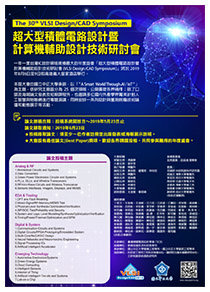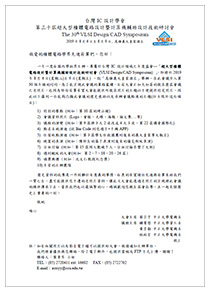Oral 10: Emerging Trends of Intelligent Healthcare
Session Chair: Shanq-Jang Ruan (National Taiwan University of Science and Technology)Date: Aug. 8 (Thu.), 2019
Time: 11:30 – 12:30
Room: 6F 御廳
| 順序 | 口頭報告論文 |
| 1 | 11:30 – 11:42 (S0095) A Low-Power Multi-mode Sensing Device for Sleep Apnea Homecare Po-Cheng Hsu, Yu-Chiang Cheng, and Hsi-Pin Ma National Tsing Hua University Abstract: In this paper, we proposed a low-power wearable device that can support various operation modes for sleep apnea homecare. The proposed device measures temperature, humidity, ECG, respiration, and body posture. The body posture part provides two modes, which are ECG-3axis mode and ECG-9axis mode. It let user to select to measure 3-axis signal or 9-axis signal. In terms of data storage, two versions are available. The Bluetooth version and the NAND Flash version. In addition, we will detect the quality of ECG signal to ensure the correctness of ECG signal storage. If the ECG signal quality is poor, we close the sensor to save power and provide alerts to users. The most power-consuming mode in this sensor is ECG-9axis mode in Bluetooth version. But its average current consumption is only 7.5523mA. And in the case of a 300mAh battery, the device lifetime up to 39.72 hours. |
| 2 | 11:42 – 11:54 (S0083) Sample Preparation for Reactant Minimization on Digital Microfluidic Biochips under Timing Constraints Ling-Yen Song, Yu-Ying Li, Yung-Chun Lei, and Juinn-Dar Huang National Chiao Tung University Abstract: Sample preparation is one of the essential processes for most biochemical assays on biochips. Many studies have been conducted for dealing with the reactant minimization problem during sample preparation. Nevertheless, those approaches try to minimize reactant consumption at the cost of more extra operations, which may lead to deterioration of reactant and even wrong results. In this paper, we propose a time-constrained sample preparation algorithm for reactant minimization on digital microfluidic biochips (DMFBs). The experimental results show that our algorithm achieves a 33% reactant reduction over a delay-optimal method with the same operation time. Meanwhile, the proposed method can save 5% operation count as compared with a state-of-the-art reactant minimization algorithm under the same reactant consumption. |
| 3 | 11:54 – 12:06 (S0178) Stride Count and Walking Distance Measurement via Knee Angle Calculation Teng-Chia Wang (1), Yan-Ping Chang (1), Chun-Jui Chen (1), Chia-Chun Lin (1), Yung-Chih Chen (2), and Chun-Yao Wang (1) (1) National Tsing Hua University and (2) Yuan Ze University Abstract: To calculate the knee angle, stride counts, and walking distance, we propose a system, iKneePad, fusing two 9-axis sensors with Bluetooth equipped on the thigh and shank segments. The changing rates of hip and knee an- gles are used to determine the beginning and the ending of a stride. The thigh length, shank length, hip angle, and knee angle are used to calculate the walking distance. The experimental results show that the accuracy of stride count is 100%, the absolute mean errors of knee angle are 2.99◦ and 1.42◦ for the maximum and minimum flexion angles, respectively. For walking distance, the mean error rates are -2.40% and -2.26% for short (10m) and long (33m) distances, re- spectively. The proposed system also instantly provides feedback to users by showing on an Android smartphone when conducting rehabilitation or exercise with iKneePad. |
| 4 | 12:06 – 12:18 (S0213) Wearable Parkinson's Disease Finger Tapping Quantitative Evaluation Chip Design Combined with Impedance and Accelerometer Sensing Yu-Chuan Lu (1), Zhi-Xiong Feng (1), and I-Chyn Wey (1,2) (1) Chang Gung University and (2) Chang Gung Memorial Hospital Abstract: In this paper, we proposed the use of accelerometers and impedance measurements to achieve a wearable sensing chip design that can assess the finger tapping quantitative evaluation in patients with Parkinson's disease. The accelerometer is used to measure and evaluate the large motion, and the impedance measurement is used for the fine detail of finger tapping. By evaluating the condition of 10 subjects in normal finger tapping and comparing them with the simulated PD’s shakings, the proposed approach processes the sensing signals and computes the characteristic signals in time domain, which is more timing, power, and hardware efficient. In this way, we can accurately distinguish the symptoms of finger fibrillation in patients with PD and meet the wearable demand as well. |
| 5 | 12:18 – 12:30 (S0197) Fast Remaining Useful Life Estimation by Using K-means-based Data Labeling Mechanism and Non-time Related Artificial Neural Network Kun-Chih (Jimmy) Chen and Geng-Ming (Kevin) Liu National Sun Yat-sen University Abstract: Health prognostic benefits the industry by maintaining machinery in more efficient way and been widely discussed since the fourth industrial revolution. However, due to the unpredictable human error and uncontrollable chain reaction during the machine operation, it is difficult to estimate the remaining useful life (RUL) of the machinery with a lite estimating method, which leads to large computing power and cost. To consider the tradeoff problem between computing cost and the efficiency of RUL estimation, we propose a kind of artificial neural network (ANN) accompany with a K-means- based labeling algorithm to construct feasible targets (i.e., health prognostic) for learning. Compared with the conventional approaches, the proposed method does not need the historical data and achieve similar RUL estimation results with much lower computational complexity. |
指導單位:
教育部資訊及科技教育司
主辦單位:
臺灣積體電路設計學會
承辦單位:
國立中正大學電機工程學系
國立中正大學資訊工程學系
協辦單位:
科技部工程司工程科技推展中心
國研院台灣半導體研究中心
中國電機工程學會
智慧聯網整合推動聯盟中心
中央研究院資訊科學研究所
贊助單位:
聯發科技股份有限公司
日月光半導體製造股份有限公司
威鋒電子股份有限公司
奇景光電股份有限公司
荷蘭商益華國際電腦科技(股)公司台灣分公司
台灣新思科技股份有限公司
財團法人工業技術研究院
瑞昱半導體股份有限公司
聯詠科技股份有限公司
鈦思科技股份有限公司
台灣是德科技股份有限公司
和澄科技股份有限公司
愛爾蘭商明導股份有限公司台灣分公司
一元素科技股份有限公司
力旺電子股份有限公司
博鑫醫電股份有限公司
群聯電子股份有限公司
晶心科技股份有限公司




